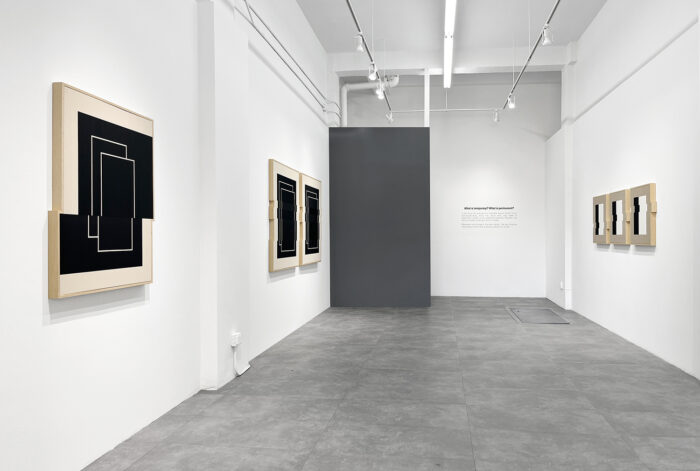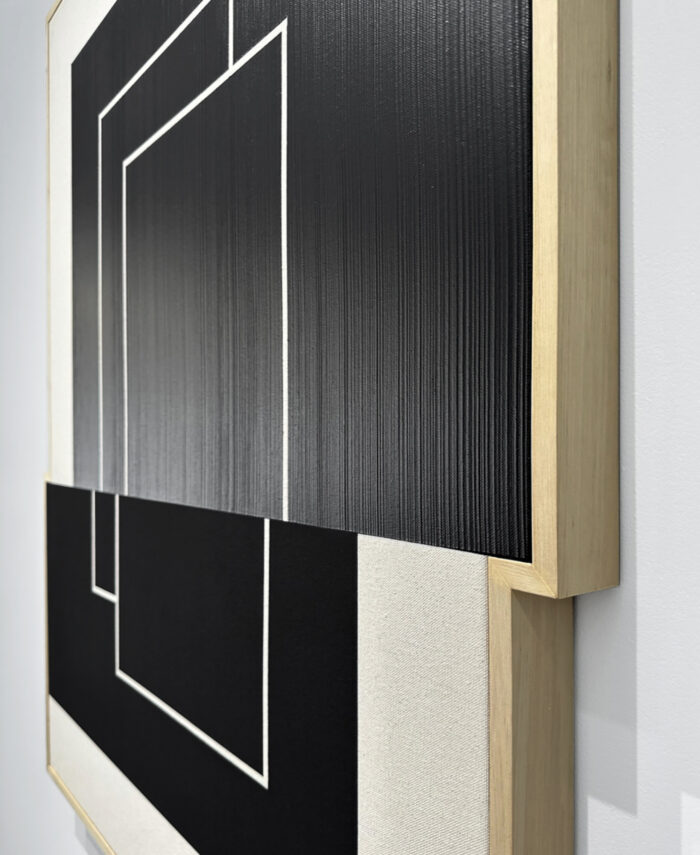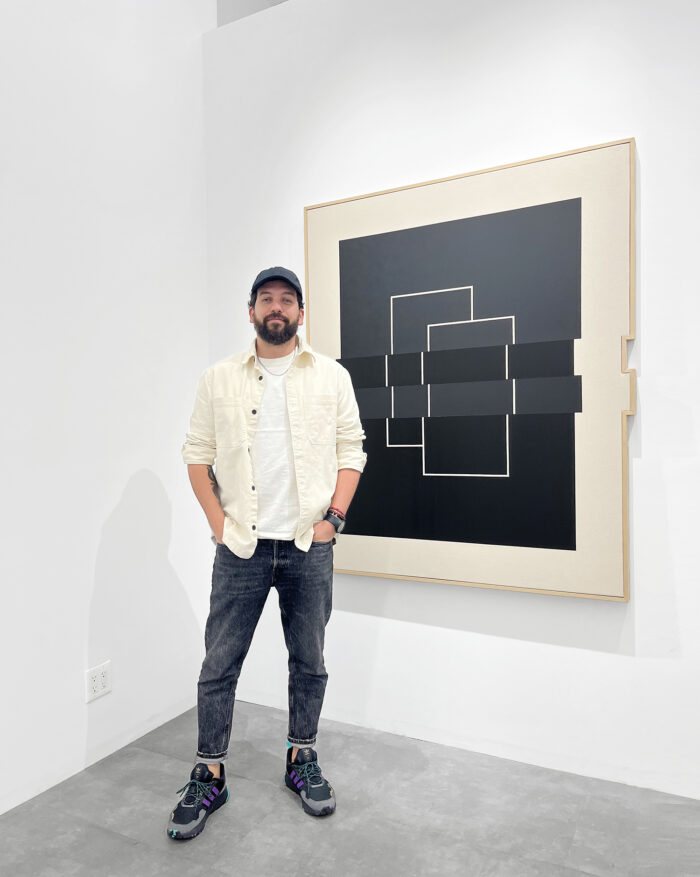
SCREEN I: Guillermo Garcia Cruz at Kates-Ferri Projects
September 7 – October 10, 2023
JM: What initially inspired or motivated you to pursue a career in visual art, and can you share a pivotal moment or experience that solidified your passion for it?”
GG: I’ve been interested in artistic activities since I was a little kid. I remember the first class I took was ceramics, at 5 years old. I was very curious about any materials and objects I found on the floor. I would pick it up and try to use it to draw, whether on a piece of paper, on the walls of my room, or on my toys.
Then I started to experiment with many different fields, like animation, caricature, illustration, and comics. I loved everything related to drawing and painting and tried to learn as much as I could.
Towards the end of high school, I started thinking about art as a way of life and perhaps also as a career. After graduating (with a major in teaching), I began working for different companies as a designer and illustrator. I quickly realized that I did not like to make things following someone else’s orders. I was working long nights around tight deadlines and I felt this was stifling my creativity. What I liked most about art was the freedom to create what I wanted the way I wanted and when I wanted.
That is when I decided to focus on visual arts. As a first step, I looked for residencies, courses, and colleagues that would help me to understand the theoretical part of contemporary art so that I could apply my previous knowledge to this complex world. It was not easy at the beginning, but with time, I realized that when you work in the arts, you never stop learning. I fully embraced that mindset and I constantly strive to learn.
JM: Could you share some insights into your creative process and the emotions or concepts that inspire your abstract paintings?
GG: My recent work consists of a series of paintings and sculptures strongly influenced by the formal legacy left by Latin American geometric art, Brazilian concretism, and modern national constructivism, as well as the production of the Uruguayan-Argentinian MADI movement from the 1940s. According to the group of artists in this movement, painting should not be confined to a rectangular canvas; instead, the shape of the canvas should follow the structure of the painting.
I build on this legacy by re-interpreting it in the context of what I view as our contemporary problems. In particular, the different ruptures that occur within my works reflect the ruptures in our lives and our societies; my paintings and sculptures are always on the verge of separating, multiplying in other parts, or seeking their own life by fragmenting their body structure into the contextual space. Historically, we can relate this act of rupture to a reflection on the project of modernity and its collapse in Latin American contexts, as well as our current moment of global changes where we feel disoriented and anxious about what is to come.
The general idea, in this case, is an attempt to disorient the viewer’s perception of the plane of the work and produce a noise effect, like a temporal error or a “GLITCH,” a term that comes from the world of computing, the digital realm, and refers to a temporal error which may or may not be corrected, an analogy to the consequences of the constant and global changes that increasingly affect us as individuals. Repetition, movement, transformation, and the boundaries between the interior and exterior are some of the visible concerns in these works and are presented in different ways, within individual works, polyptychs, installations, and sculptures, in a constant quest to expand the dialogue between form and meaning.”

JM: How do you typically start the creative process when embarking on a new painting and sculpture?
GG: I would say that my creative process starts the moment I begin working on a specific project, rather than a specific painting. I like to think about big installations of paintings together, more than as individual pieces. Thus, while I work on the main ideas I would like to investigate, I conduct experiments on different materials, formats, and techniques, in an initial process that I like to call the “expansive phase”, where I try not to worry too much about any kind of limit.
Then, I move to the “selective phase”, where I look at these visual experiments and I decide which one of them makes more sense to convey the themes I want to talk about, and the questions I want to ask.
As for the practice, I constantly move back and forth between doing sketches of paintings and actually painting. I do both manual pencil sketches and digital sketches. Manual work is equally important to digital visualization for me. Individual pieces become meaningful when they respond and take part in a bigger system of paintings, sculptures, or objects that are created to explore certain thoughts.

JM: Could you provide some insights into the specific artwork titled ‘Screen XXIIINY f’? What inspired this particular piece, and how did you approach its creation and execution?
GG: This piece is the biggest painting in the exhibition Screen I. I think that every piece is important in my painting installations but the biggest and the smallest pieces are the ones that require more of my attention. Because of the nature of this glitched canvas, you get more of the sense of a flat painting in the big piece, while the small one feels more like a small object or sculpture.
For that reason, this big piece is the one that takes more work in terms of studio time, and also more dedication, because as the surface gets bigger, the flatness and texture become more evident. Thus, the action over that surface becomes more related to the movement of the body than the movement of the hand.
The large piece is also especially important in terms of what is specifically represented in this piece. The main concept of my work is creating relations between geometric abstractions with visual symbols coming from the digital language. In this piece, for the very first time, I am doing some experiments with the multiplication of screens. This comes from the visual manifestation of a critical error and a “frozen” screen in software.
JM: What inspired your choice of color palette, or the deliberate absence of color, in this particular artwork, and how do you believe it enhances the overall message or emotional impact of the piece?
GG: The colors I use are also within the conceptual framework of the research. Therefore, the choice of colors is also related to the digital world. As the title of the exhibition and the works indicate, the elements that appear are related to screens. Black represents the static and neutral state of the screen, that is, the turned-off screen. Black is the complete absence of light colors, and on the other hand, from a pictorial perspective, it represents the theoretical sum of all pigment colors. Although it is not possible to determine the universality of the interpretation of this color, since I was able to see and study Malevich’s work, I understood the symbolic importance of the color black, not as an emptiness but as an endless array of meanings.

JM: Do you have any upcoming plans or additional projects you’d like to discuss?
GG: Sure! I’m really excited about the projects ahead. At this moment I’m working on the production for my solo Booth at the Untitled Art Fair titled “Critical Error” December 6-10th in Miami, with Kates-Ferri Projects. It will be a further evolution of the process underlying the exhibition at the gallery. I think is a very good opportunity to show my work in an art fair that I have always liked because of their high-quality curation overseen by artistic director, Omar Lopez-Chahoud. One of the themes this year is Curating in the Digital Age, thus I hope my work will resonate with the art enthusiasts attending the fair.
The combination of the solo exhibition and the Untitled Art Fair allows me to present my work to a new audience. While the Latin American public is well acquainted with the language of geometric abstraction, bringing my art practice to the American spectators is a different challenge, and I am excited to see their reactions and feedback. As I said, I am constantly learning.
